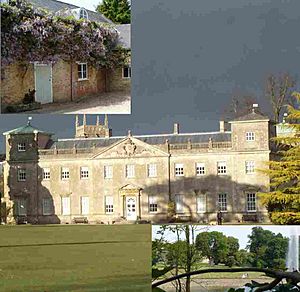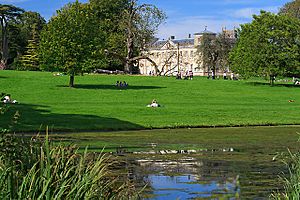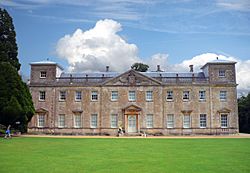Lydiard Park facts for kids
Lydiard Park is a large country park covering about 260 acres (105 hectares). It is located near Lydiard Tregoze, which is about 3 miles (5 km) west of Swindon, Wiltshire, England. The park is close to Junction 16 of the M4 motorway.
Contents
A Look Back: Lydiard Park's History
Lydiard Park has a long history! A settlement called Lediar was mentioned in the Domesday Book. This was a very old survey of England from 1086. The Tregoze family owned the land from around 1198.
In 1259, King Henry III allowed Robert Tregoze to create a deer park in the nearby woods. This was a special area where deer could live and be hunted. Later, in 1420, the estate passed to the St John family through marriage. They owned Lydiard Park for a very long time, right up until World War II.
Changes Over the Centuries
In the 1600s, the old medieval house at Lydiard was changed. Formal gardens and a canal were added. Sir John St John also created straight paths called "avenues" across the park. However, many of these formal designs were removed by 1766.
Some older features from the 1700s still exist today. These include a special underground building called an ice house. People used it to store ice all year round! There is also a walled garden with a bronze sundial in the middle. Large parts of the park were sold off in the 1920s and 1930s.
Lydiard Park During World War II
During World War II, Lydiard Park was used as a military hospital. First, it helped American soldiers. Then, from about 1943 to 1946, it became a hospital for German prisoners of war. It was known as POW camp No. 160.
In 1943, a local leader named Francis Akers bought the estate and the old house. He then sold it to the local council, the Corporation of Swindon, for £4,500.
Since 1955, Lydiard Park has been open for everyone to enjoy all year. In 1987, the park was recognized as a special historic site. It is a great example of a park from the mid-1700s. It also shows signs of its even older 1600s design.
In 2005, Swindon Borough Council received £3 million to help restore the park. This project included bringing back a two-acre lake. Lydiard Park even hosted Radio 1's Big Weekend in 2009, which is a big music event!
Lydiard House: A Historic Home
The main house, known as Lydiard House, is very old. It started as a medieval building. It was updated in the 1600s and again in the 1740s. During these updates, the south and east sides of the house were rebuilt in a grand style called Palladian. This was probably done by an architect named Roger Morris. In 1955, the house was given a special Grade I listing. This means it is a very important historic building.
Bringing the House Back to Life
When Swindon Corporation bought the estate, most of the original furniture was gone. In the 1950s, the council started collecting items to furnish the house. They especially wanted to restore the 18th-century State Rooms.
Their efforts were helped in 1955 when some good furniture was loaned to the house. This came from a special collection. Later, in the 1960s, Lord Bolingbroke loaned several family portraits to the house. He later sold them to the council. When he passed away in 1974, he left everything he owned from the house to its trustees.
Today, Swindon Borough Council owns and manages both the house and the park. The house is open to the public during the summer months. You can see its collections of furniture and art. This includes beautiful painted wall panels by Lady Diana Beauclerk. The house and a modern building next to it are also used for conferences and weddings.
The Church of St Mary
Right next to Lydiard House is the parish church of St Mary. This church is all that remains of the old medieval village. The church itself dates back to the 1200s. It was updated and made bigger in the 1400s and 1600s. Like the house, it is also a Grade I listed building.
Images for kids







